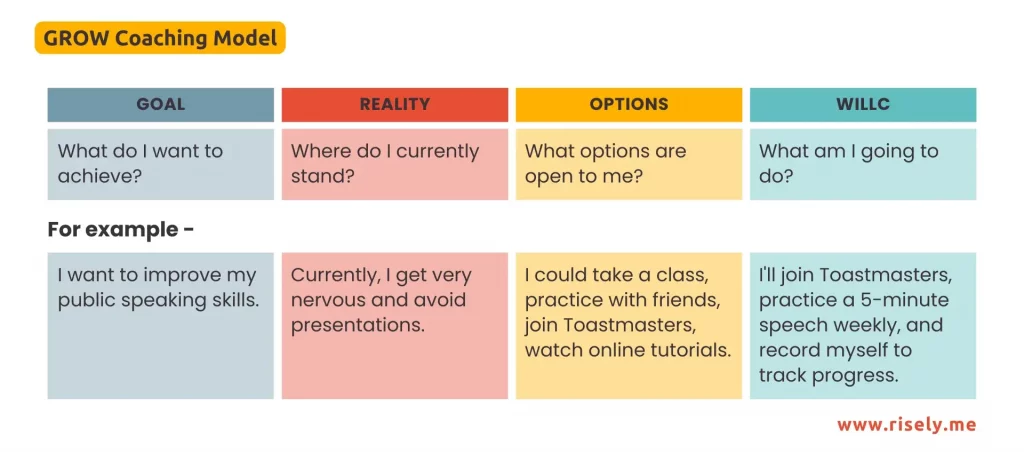5 Steps to Get Started with GROW Coaching Model
As a coach, you strive to empower your clients to reach their full potential. Sometimes, however, knowing where to start or how to help them achieve their goals can be challenging. This is where the GROW coaching model comes in. The acronym stands for Goal, Reality, Options, and Will. It is a powerful tool that provides a structured approach to coaching and helps individuals move from where they are now to where they want to be. This blog post will dive deep into the GROW coaching model. We will cover its four stages and explain why it is so effective. We will also provide examples of successful applications of the GROW coaching model in various contexts and give concrete steps to implement it in your practice. By the end of this post, you will have all the information you need to leverage this powerful coaching tool and help your clients achieve their goals like never before!What is the GROW coaching model?
The GROW coaching model rose to fame in the 1980s, when Sir John Whitmore and Graham Alexander presented it in their book Coaching for Performance. It soon became a widely used methodology for personal development and goal-setting. The GROW coaching model guides coaching conversations through the four stages of Goal, Reality, Options, and Will, helping your clients gain clarity and take actionable steps toward their desired outcomes. The GROW coaching model is effective for several reasons, but the most important is it’s people centric approach. Unlike other systems that rely heavily on what the learner wants to achive, GROW coaching pushes us to look inside and stay in tune with reality. While the system has four structured steps, it is quite flexible too, as the coaches keep going back and forth when needed. Plus, it ties in effectively with the idea of setting SMART goals.What are the four stages of the GROW coaching model?
The GROW model consists of four key stages, which are typically represented by the acronym GROW. Let’s understand each of them in detail and follow through with an example. Suppose you are a new manager, and you want to lead effective meetings. Upon taking a communication skills assessment, you have noticed that your public speaking skills need a boost. What should you do next?
- Goal: In this initial stage, the coach/manager and coachee (the person being coached) work together to set smart goals as a team and establish clear and specific goals. These goals should be SMART, which stands for Specific, Measurable, Achievable, Relevant, and Time-bound. The coach helps the coachee define their goals and ensures that they are realistic and attainable. For e.g., we can start with “I want to improve my public speaking skills in the next quarter.”
- Reality: Once the goals are established, the next step is to explore the coachee’s current reality. This involves taking an honest and objective look at the present situation. The coach asks questions to help the coachee understand where they are right now, what resources they have available, what obstacles they may face, and what progress they have made toward their goals.
- Options (or Opportunities): In this stage, the coach and coachee brainstorm and explore various options and strategies for achieving the established goals. The focus is on generating a wide range of possibilities without judgment. The coach encourages the coachee to think creatively and consider different approaches to overcoming obstacles and reaching their objectives.
- Will (or Way Forward): The final stage of the GROW model involves creating a concrete action plan. The coachee decides which options or strategies they will pursue to achieve their goals and sets specific actions, deadlines, and responsibilities. This stage emphasizes commitment and accountability, like in our example, we commit to a weekly practice of 5 minutes. The coach may also help the coachee set up a system for monitoring progress and making necessary adjustments.
Let’s check out a few more examples of the grow coaching model in action.
By the way, you can ask Merlin, Risely’s AI coach, to do this with you in case your coach is not available at the moment. Try it out now with whatever is bugging you, it’s a free first chat!Example 1: Career development with GROW coaching
- Goal: The coachee wants to advance in their career and take on a leadership role within their organization.
- Reality: The coachee currently holds a mid-level position and lacks experience in leadership roles. They have good technical skills but need to develop leadership competencies.
- Options: During this stage, the coach and coachee brainstorm potential options. These might include seeking mentorship from a senior leader, enrolling in leadership development courses, volunteering for leadership projects, or identifying specific leadership skills to improve.
- Will (Way Forward): The coachee decides to seek mentorship from a senior leader, enroll in a leadership development program, and set a goal to lead a cross-functional team within the following year. They establish a timeline, identify milestones, and commit to regular check-ins with the coach to track progress.
Example 2: Using GROW coaching for health goals
- Goal: The aim to improve their overall health and well-being by losing weight and adopting a healthier lifestyle.
- Reality: The coachee is currently overweight, sedentary, and struggling with unhealthy eating habits. They also have a busy work schedule.
- Options: In this stage, the coach and coachee explore various options. Options may include consulting a nutritionist, starting a workout routine, meal planning, reducing stress through mindfulness practices, or setting aside dedicated time for self-care.
- Will (Way Forward): The coachee starts by consulting a nutritionist for a personalized meal plan. They commit to exercising for 30 minutes three times a week, practicing mindfulness for stress reduction, and scheduling regular check-ins with the coach to monitor their progress. The coachee sets specific weight loss and fitness goals with timeframes.
Other Interesting Reads
What are the steps in implementing the GROW coaching model?
Implementing the GROW coaching model requires you to begin by recognizing a couple of things:- First, you are the manager acting as the coach for your team. At this point, you are committed to your company’s vision and simultaneously to the betterment of your team members in areas that matter to their professional growth.
- The coach’s role is to facilitate rather than direct. In the reality stage, the coach plays the devil’s advocate to ensure the goal is rooted in truth.
#1 Establish the Coaching Relationship
Start by building a rapport and trust with the team member you are a coaching. Create a safe and comfortable environment where they feel free to express themselves. It could include starting with some ice-breaker questions to know your team better, building a common ground over personal interests, etc. before heading to the main topic at hand. You will also have to clearly define the roles and expectations of both the coach and the coachee. Ensure the coachee understands the purpose and benefits of coaching.#2 Set the Stage for the Coaching Session
Begin the coaching session by clarifying its purpose and agenda, as we noted in the first step. Next, discuss what the coachee hopes to achieve during the session. If necessary, remind the coachee of the confidentiality of the coaching relationship to encourage open and honest communication.#3 Follow the GROW Model
Guide the coaching conversation through the four stages of the GROW model:- Goal: Help the coachee articulate specific, measurable, achievable, relevant, and time-bound goals.
- Reality: Encourage the coachee to explore their current situation, including challenges, resources, and progress toward their goals.
- Options: Facilitate a brainstorming session to generate possible strategies and approaches.
- Will (Way Forward): Assist the coachee in creating a concrete action plan, including specific actions, timelines, and accountability measures.
Use Risely’s free GROW coaching model worksheet to make it easier!
People management resources by Risely – your buddy on this journey of growth.
#4 Ask the right questions
Throughout the coaching session, you should practice active listening to understand the coachee’s perspective and emotions. Use powerful questioning techniques to stimulate reflection and critical thinking. A few examples of GROW coaching model questions for every stage are: Goal Stage Questions:- What do you want to achieve?
- How will you know when you’ve reached your goal?
- What does success look like to you?
- What is happening right now?
- What have you already tried?
- What are the current challenges you’re facing?
- What possible approaches could you take?
- If you had unlimited resources, what would you do?
- What alternatives have you not considered yet?
- Which option feels most compelling to you?
- What specific actions will you take?
- When exactly will you start?
# 5 Close the Coaching Session
Towards the end of the session, summarize the key points discussed during the session. Ensure clarity and alignment on the goals and action plan. Secondly, you must encourage the coachee to commit to their action plan and discuss any potential obstacles or challenges they may encounter. You can also join in as their accountability partner. Also, don’t forget to schedule follow-up sessions to monitor progress, provide support, and adjust the plan. Remember that successful implementation of the GROW coaching model requires practice and adaptability. As coaches, you should be flexible and responsive to the coachee’s needs and the specific context of each coaching session. Maintaining confidentiality, respect, and a non-judgmental attitude is crucial for creating a supportive coaching environment.Your role as the facilitator of GROW coaching
As the team leader, coaching your people is integral to your role. The good part of the GROW coaching model is that it does not position you as the expert on the challenge that your team member is facing. Instead, you are the facilitator who ensure that the team member is able to find their way and stick to it. In order to get this right, there are a few best practices of GROW coaching that you should keep in mind.- Always listen actively and follow up with clarifying questions
- Allow silence for reflection
- Avoid leading questions that suggest a specific answer
- Encourage the coachee to dig deep and be honest
- Maintain a non-judgmental and supportive tone
Conclusion
The GROW coaching model provides a structured framework to guide coaching conversations and facilitate personal growth and development. By following the four stages of setting goals, assessing reality, identifying options, and establishing a will, coaches can help individuals clarify their objectives, explore their current situation, brainstorm potential solutions, and commit to action. The success of the GROW model lies in its ability to empower individuals to take ownership of their growth journey and make meaningful progress toward their goals. Whether you are a coach looking to enhance your practice or an individual seeking personal development, incorporating the GROW coaching model can be a valuable tool for achieving positive change. The first step towards implementing the GROW coaching model is establishing trust, setting SMART goals, and exploring reality with your coachee.Grab your free copy of the GROW coaching model worksheet!
People management resources by Risely – your buddy on this journey of growth.
Other Related Blogs
Performance Management Training: Empowering Managers To Manage Better
Performance Management Training: Empowering Managers To Manage Better Remember that feeling of dread when you knew performance review season was rolling around? Yeah, us, too. For many employees, performance reviews…
Manager Development Goals And How To Reach Them: Opportunities And Areas To Focus On
Manager Development Goals And How To Reach Them: Opportunities And Areas To Focus On You’ve meticulously crafted a development program for your high-potential employees, but their managers just aren’t on…
Leader Competence: The Cornerstone of Effective Leadership Development
Leader Competence: The Cornerstone of Effective Leadership Development Imagine you’re leading a talented team, but somehow, projects are stalling, and motivation seems slipping. You see the potential in your people,…
Confused by L&D Metrics? Here’s How to Focus on What Matters
Confused by L&D Metrics? Here’s How to Focus on What Matters You’ve undoubtedly witnessed companies celebrating a record number of employees completing leadership training programs. Champagne toasts erupt, press releases…


